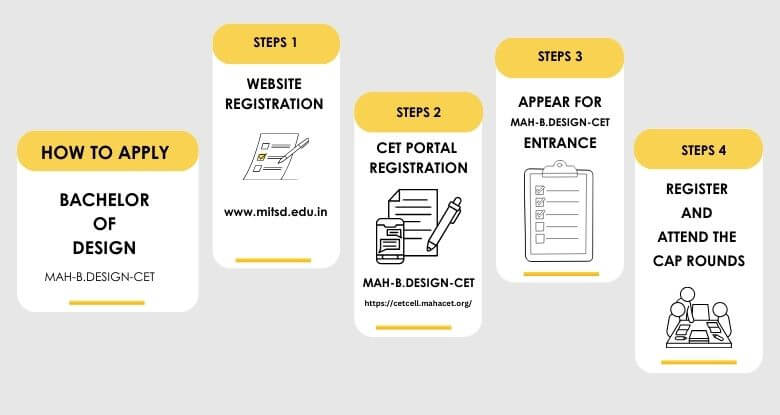Overview of UI (User Interface) and UX (User Experience) design.
Importance of UI/UX in creating intuitive and engaging digital products.
Aesthetics enhance the visual appeal and emotional connection, making the product attractive to consumers. Innovation drives creativity and the incorporation of new technologies or ideas, resulting in unique solutions that enhance user experience and differentiate products in the market.
B.Des Program: 10+2 (Any of the State Boards/ CBSE/ ICSE/ ISC/ CIE/ IB/ NIOS or equivalent exam) from any stream.
Go to the official website of MIT Institute of Design (MITSD) or MIT School of Design. Look for the Admissions section on the homepage.
Admissions only through MAH-B Design CET entrance exam.
College Code - 06146.

List of 8 Career opportunities
MIT School of Design (MITSD) in Pune offers a UI/UX design course grounded in design thinking and powered by cutting-edge tools and technology. The program is mentored by Prof. Uday Athavankar, a distinguished architect from J J School of Arts and former professor at IIT Bombay, who brings over 50 years of experience in design education and consulting. A pioneer in integrating new technologies and research-driven methods into design, Prof. Athavankar has significantly shaped India's design education landscape. The curriculum focuses on hands-on learning, industry exposure, and user-centered design, preparing students to tackle real-world challenges.
MITSD promotes innovation and creativity by leveraging a team of experienced faculty members from esteemed institutions such as MITID Pune and the Indian Institute of Science (IISc) Bangalore, along with state-of-the-art facilities. This combination equips students with the skills needed to thrive in the rapidly changing field of UI/UX design.
- Tips for visiting campuses and talking to current students.
A successful career in UI/UX requires a blend of technical and soft skills. Key skills include user research and testing to understand user needs, prototyping and wireframing for effective design visualization, and interaction design to create intuitive user experiences. Additionally, strong communication skills are essential for collaborating with teams and presenting design concepts, while a solid understanding of visual design principles enhances the overall aesthetic and usability of digital products.
MIT SD’s UX design course prepares students for real-world challenges by offering a comprehensive curriculum that combines theory with practical application. Students engage in hands-on projects, collaborate with industry professionals, and participate in user research and testing to develop a deep understanding of user-centered design. The course emphasizes critical thinking, problem-solving, and adaptability, equipping students with the skills needed to navigate the fast-evolving design landscape and address diverse user needs effectively.
After pursuing UI/UX design, graduates can explore a range of career opportunities, including roles such as UX Designer, focusing on enhancing user experiences, and UI Designer, specializing in the visual aspects of digital interfaces. Other options include Interaction Designer, Product Designer, and User Researcher, all of which involve creating user-centered solutions. Additionally, graduates may work in design consulting, project management, or even launch their own startups, contributing to various industries like technology, healthcare, and e-commerce.
In UI/UX design education, students typically use a variety of tools and software to develop their skills. Commonly used design tools include Adobe XD and Figma for creating wireframes and prototypes, as well as Sketch for interface design. Students also learn to utilize InVision for prototyping and collaboration, and Axure for advanced interactive designs. Additionally, tools like UsabilityHub and Lookback are employed for user testing and feedback, enhancing the overall design process.
UI design (User Interface design) focuses on the visual and interactive elements of a product, such as buttons, icons, and layout, ensuring that the interface is aesthetically pleasing and easy to navigate. In contrast, UX design (User Experience design) encompasses the overall experience a user has with a product, including usability, functionality, and the emotional response to the product. While UI is about the look and feel, UX is about the overall journey and satisfaction of the user when interacting with the product.
User research plays a crucial role in UX design by gathering insights about user behaviors, needs, and preferences. It helps designers understand the target audience, identify pain points, and validate design concepts through methods such as surveys, interviews, and usability testing. This research informs the design process, ensuring that solutions are user-centered and effective in addressing real-world challenges, ultimately leading to improved user satisfaction and engagement.
Wireframing is essential in the UX process as it provides a visual blueprint of a product’s layout and functionality. It helps designers outline the structure, prioritize content, and define user interactions before moving on to more detailed design stages. By creating wireframes, teams can effectively communicate ideas, gather feedback early in the design process, and make necessary adjustments, ultimately leading to a more user-centered final product.
After completing a UI/UX design course at MIT SD, you can explore various job roles such as UX Designer, focusing on enhancing user experiences, and UI Designer, specializing in creating visually appealing interfaces. Other opportunities include Interaction Designer, Product Designer, and User Researcher, all aimed at improving usability and user satisfaction. Additionally, you may consider roles in Design Consulting or Project Management, allowing you to contribute to diverse industries and projects.
UI/UX designers are sought after by a wide range of companies across various industries. Tech companies, including software development firms and startups, often hire designers to create user-friendly applications and websites. Additionally, e-commerce companies, digital marketing agencies, and gaming companies value UI/UX designers for enhancing customer engagement and satisfaction. Non-profit organizations and educational institutions also seek these professionals to improve user experiences on their platforms.